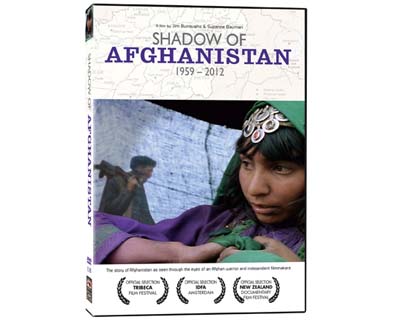In recent months, two interesting documentary films covering the conflicts in Afghanistan during the last four decades have been released.
Shadow of Afghanistan: 1959-2012 is a compilation of over 100 hours of video shots by two Oscar-nominated filmmakers Jim Burroughs and Suzanne Bauman, who made 18 trips to Afghanistan over the last 26 years of war and chaos. The film is now released with publication of Blood on the Lens: A Filmaker's Quest for Truth in Afghanistan, which describes the making of the documentary over the course of two decades, during which two crew members Lee Shapiro and James Lindelof were killed by Soviet troops when they were caught in a firefight with Mujahideen.
With some fascinating footage from 50s and 60s era before war, the documentary covers complex aspects of the tragedy that has been known as Afghanistan for decades. It tells the story of the Afghan generation of my age, who were born during the Soviet occupation and since have experienced an unending cycle of conflicts caused by the regional great games of super powers and our neighbors.
The film starts with 9/11 scenes of the plane-crash into the twin towers and comments of Afghan 'resistance' commander of National Islamic Front Wakil Akbarzai, the main liaison who organizes the trips and works as translator for the two American filmmakers, who are out to complete the documentary by their friends Lee Shapiro and James Lindelof. Another Afghan, Fatima Gilani, daughter of Pir Sayed Ahmad Gailani, the leader of National Islamic Front also comments throughout the film. With the political affiliation of both Afghan 'experts', one should know that their views are not reflective of average Afghan perspective.
As one among the generation of Afghans who were born during Soviet invasion, experiencing the last decades of conflicts, particularly those millions who fled the country as refugees, I would have been particularly interested to see views of the non-Mujahideen Afghans during the anti-Soviet resistance reflected equally. I have not come across a single American documentary about the Soviet invasion and following chaos in Afghanistan to have covered the perspectives of progressive and liberal Afghans of that era. With their particular political affiliation, contention is reflected in the commentary of the two Afghan experts in the documentary, especially when Wakil Akbarzai talks of the civil war in Kabul among Mujahideen factions.
The film is very informative and a good revision for anyone interested in Afghanistan and it's recent history of conflict and chaos. However, from the title Shadow of Afghanistan: 1959-2012, which covers 20 years of work by renown filmmakers, I had expected a more in-depth analysis of the situation from Soviet invasion to today's Taliban resistance.
In fact the movie does not cover much after the US and NATO arrival in 2001.
Afghanistan's poverty, illiteracy, religious extremism and other problems were not exclusively caused after the Soviet invasion, rather it's rooted far back.
Shadow of Afghanistan is a passionate work of great courage by two filmmakers who, despite murder of their two friends on this documentary mission, risk their lives on frontlines with Afghan fighters and go to refugee camps on Afghanistan-Pakistan border and follow events in the country throughout decades of chaos that witness from withdrawal of Soviet troops and factional civil war among Mujahideen to rise of Taliban and their alliance with Al-Qaeda, the bloodthirsty group of Arab terrorists who make Afghanistan their launching pad for 9/11 attacks, when the US finally wakes up to the blunder of its own—abandoning and ignoring Afghanistan after Soviet withdrawal.
However, the film does not give an in-depth analysis of how it all led to that situation. With a slight focus on war-journalism, as two crew members of the movie were killed, it does not tell the story of how irresponsibly the mainstream American media covered the Soviet invasion of Afghanistan and following events.
The role of American press and the way they reported the Afghan resistance is important. A radical transformation of fanatic thoughts during the 'Afghan Jihad' against Soviet Union was overlooked with the indiscriminate and unaccountable assistance of the US to the radical Islamist Mujahideen factions. It was those last years of the anti-Soviet resistance that Osama Bin Ladin and influx of angry Arab fighters penetrated and radicalized some Mujahideen. And later it was them who used Afghanistan as training ground for Arab Jihadis to spread terror across the globe. How could the US remain unaware of all this radicalization happening? And what responsibility comes to the questionable role of American press in that era?
It was millions of US taxpayers' money that was used in support of the Afghan Mujahideen resistance against Soviet forces and the American press coverage was biased in favor of Mujahideen to the point that it overlooked the radicalization and much more disturbing anti-American extremism growing in that era. The journalist community of American Club did their all reporting for all major US media outlets from the University Town of Peshawar in Pakistan. Robert Darr in his book The Spy of the Heart tells this story in some detail.
Shadow of Afghanistan strikingly portrays the tragedies of war, hardships of millions of Afghan refugees who fled the country during the Soviet invasion, children who are victim of land mines and Taliban brutality that was Afghanistan's darkest era of history.

